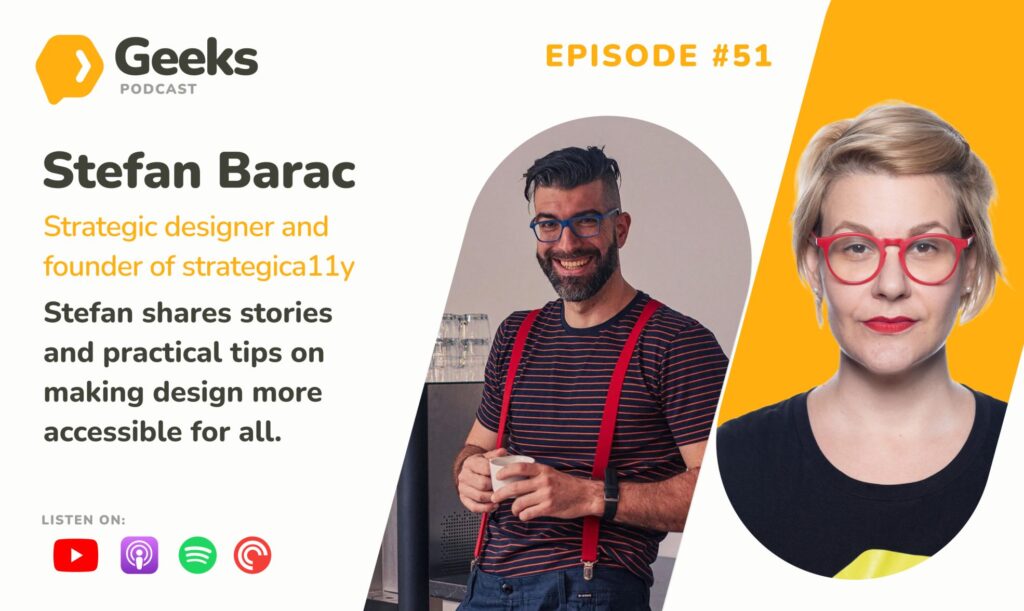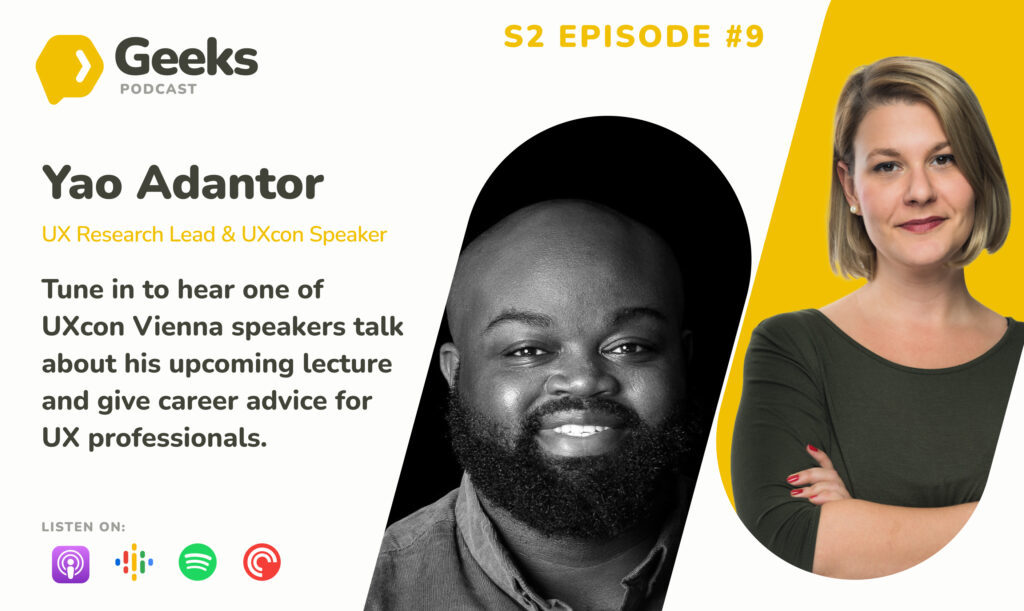Episode highlights
00:01:28 Erika’s Entry into Content Design
00:03:38 Diving Deeper into Content Design and Discussing Erika’s Book
00:14:14 Bridging the Gap between Content Design and Traditional Design
00:20:01 Silver plan confusion example
00:27:19 Connect with Erica
About our guest Erica Jorgensen
Erica Jorgensen is a content professional serving as Staff Content Designer at Chewy.com. With expertise in content strategy, UX content design, and content research, she’s a prominent speaker at conferences and podcasts. Erica is also the author of “Strategic Content Design: Tools and Research Techniques for Better UX”. Her wide-ranging background includes branding, SEO, digital content, and product development, making her a versatile professional in the field. She’s an advocate for accessible and inclusive content and and enjoys mentoring UX newcomers. Connect with Erica on LinkedIn to learn more about her work.
Podcast transcript
[00:00:00] Tina Ličková:
Welcome to UX Research Geeks, where we geek out with researchers from all around the world on topics they are passionate about. I’m your host Tina Ličková, a researcher and a strategist, and this podcast is brought to you by UXtweak, an all-in-one UX research tool.
This is the 19th episode of UXR Geeks. And we spoke to Erika, who is a staff content designer at QB. com and the author of Strategic Content Design, Tools and Research Techniques for Better UX, published in April this year by Rosenthal Media. She’s a content designer, content strategist, and team leader determined to bring greater respect to the content design field.
We talked about content research and why is it important. You will listen to some very nice examples. Why is it important? Why does it help a business? And you might also learn a things or two on how to research on words.
I would never say that I understand content or content design, but I have great respect because I always had a blast or I was honored to work with really good people of words. How did you get into content design?
[00:01:28] Erica Jorgensen: I can’t, I think so many people I fell into it. I started. My career in journalism, so was always writing, writing, writing to size.
A while ago, when newspapers weren’t digital, you had only so many inches to write and you’d have to write small. And I guess that experience helped me get a job at Amazon. When it was a startup, so they needed someone who could write a whole lot of book reviews very quickly because they didn’t have any on the website.
This is back in 1997. So I wrote, I was at Amazon until about 2001, but writing and that was e commerce and that we didn’t have a lot of navigation on the site. We didn’t have, we didn’t need navigation until we added new product lines. So they had only books when I started and then they added music and then they added video and then we weren’t sure how to put that on the website.
How do we arrange that? And so we thought of file folders. We took the physical and made it digital. And that was a little bit of content design. That was definitely information architecture. But to me, looking back, there are many elements of content design in that work. And since then, I worked at places like Expedia and Nordstrom’s website.
And Microsoft and the skills that I had that I tripped into this area translated very well, which, and I know a lot of former journalists who are in content design. Yeah. I think there’s, I think there’s elements of content strategy to researching, understanding what does the customer need? What are the business needs?
Talking to stakeholders and getting facts and assimilating them, distilling them is that’s definitely a journalist thing. And there’s so many journalists who have lost their jobs. It’s fortunate that. There are rules in content design that a lot of people have been able to find. Now tech is currently having a bit of an upheaval right now, but I still know a lot of people who are leaving journalism to go into content strategy or content design.
[00:03:26] Tina Ličková: And I have the most simplest question, like what is content design? Because now you are mentioning in between lines, I heard UX copy, then it’s like a book reviews, then it’s information architecture.
[00:03:38] Erica Jorgensen: I think it’s a. It’s definitely an evolving thing, but to me, content design is determining what information the customer or audience needs to know when and where and in what format, and in that respect, there’s a lot of overlap with product design.
And I’m thinking of something I worked on yesterday where you have to think about what, if someone is buying something online and putting it in a shopping cart, how do they choose that thing? You’re presenting information to them. You’re helping them make decisions. What do they need to know when, do they need to know the price?
Do they need to know the quantity that, do they need to know how soon it will get to them? All those elements overlap with product design, product management, engineering. There’s only certain things that can happen on the backend of your website or app. A lot of them might overlap with your warehouses. I think knowing the constraints or the technical requirements of the experience is really important and that’s so much different than UX writing or content strategy when you’re understanding.
The tech side of things and what is feasible, what is possible for the customer or audience to see or get or receive that’s more technical. And it’s also writing it’s very similar to UX writing, but to me it’s got a whole lot of overlap with stakeholder input, coordinating with teams. To make the whole experience.
It’s not just plugging in words that a designer had created a wider frame for the content strategist or UX writer, and then said, here’s some more. If some of you plug it in, you plug in the words. It’s so much different than that. It’s foundationally creating an experience. And right now there’s so much overlap between product design and content design is whose role ends where whose role starts where it’s all overlapping.
And I can see maybe in 10 years that product design and content design. Become one thing, or there’s a demand for people who can do both. So it’s going into Figma, figuring out what components are right. Is this a dropdown? Is this a pop up? Is this an info chip? Is this body content and what images go well with it?
What images can support it? What, when does something need to be progressively disclosed? When do you use progressive disclosure versus putting content right at the front and center for the audience? And by content, a lot of it is, like I said earlier, it’s information. What information is the. person need to know to succeed, to do, to get their jobs, to be done.
It’s not easy to do fast. And I think there’s this pervasive misconception, content design, content writing, UX writing, any sort of content creation can be done quickly, which is completely untrue. I think it might be the most time consuming element of product creation when it comes down to it, like what you have to be consistent across experiences. If you, if I’m working on one chunk of a website or app, am I using the same words or terminology that’s in five or six or seven other parts? And so you have to coordinate with other content designers on your team. If there are ideally many people on your team, which isn’t always the case. I hope I answered your question, but it’s juggling a lot of balls.
It’s really fun, but complex, very complex. And that’s why my book is 300 pages. I didn’t mean to write a 300 page book, but it. I started writing just a little playbook for content research about content research. I thought this would be a little project to keep me busy during lockdown when COVID was really keeping everyone home.
But I found out that before you do content research, you really need to get your content house in order. You need to be able to define what do you mean by good content? How are you measuring your content? Is it tagged up to be? Analyzed by whatever analytics programs you have access to. Are you developing content heuristics?
Do you have standards for your team, for your organization when it comes to content? And because of that chronic understaffing, a lot of content teams don’t have that foundational knowledge to succeed in their roles. And that’s tough, but I think there’s lots of, there are lots of resources out there.
Content Design London has a great website. And they talk about plain language. It’s funny, wherever you turn in content design, there’s ways to be misconstrued or there’s misperceptions. It’s hard to write in plain language. Writing simple is difficult. And I think, not to get political, but I think a certain former president of the United States who talks very simply and very basic short sentences.
I’ve heard people say, I don’t want to write like him. Why would I want to write like him? I’m smarter than him. And using big words doesn’t mean that you’re necessarily smart. It means you can use big words. You need to write at the level that your audience can understand. And if they’re using an app, if they’re on the run, using an app, big words aren’t going to help them.
Keeping it simple, writing short is very difficult. I think one, one writer I admire very much is Roy Peter Clarke. He works for the Poynter Institute, a journalism institute in Florida. And he’s written many books, like How to Write Short. He’s, he, I think he’s got 10 or 12, maybe 15 books at this point, all about writing technique, writing clearly, writing effectively.
And it wouldn’t be easy if the fact that he has so many books in his backlog to his name, that’s, I think, testament to just how difficult it is. To create content, to write well, to write clearly for people to understand. When you’re writing for a broad audience, you don’t know how educated they are. You don’t know how they might have, they might be neurodiverse.
They might know many languages. If seven languages, it’s going to be hard to read an app in English. And understand it when you’re on the go, all those things, translation, localization, accessibility, all those things come into play with content design too. So it’s not just words, it’s all sorts of things.
[00:09:13] Tina Ličková: One of the things that comes up to my mind right away is this thing of, I consider senior people to be who mastered the art of simplicity, like putting complicated stuff. into simple words in the plain language, which is the term that I just heard as something that I consider to be senior. There comes the question like, okay, now we have defined the content design or we define how broad it is that it’s not just words.
I’m always remembering the first rule of design is a form follows content. And why, or I’m thinking how to phrase the question, because I remember when I was still working in UX and still doing some wireframes, I never did, or I was always fighting with people, like just not to put Lorem Ipsum, placeholder.
You need content. If it’s not even final, but we need to know what comes there. And I see, or also what I hear from you, is it the content that gives the information, how to navigate. Digital products.
[00:10:23] Erica Jorgensen: Yes, because you’re determining what is absolutely essential for the audience to know what is nice to have or nice to have later or must have later you’re structuring things in a way you’re laying out the experience and lorem ipsum literally translates to pain itself.
I believe the Latin translation plugin.
Or placeholder content might’ve been, might’ve had a great sense of humor. They were definitely onto something because when Lorem Ipsum appears in a wireframe or a design, you’re creating rework for everyone, not just the designer, not just the content designer, but the PM, the engineers, the translators, everybody suffers when Lorem Ipsum is plugged in because it means the designer and content designer were not in lockstep, they were not coordinating and collaborating. And I call it paired programming. When I sit down with a product designer and we hash out what on earth is happening here, what are the technical requirements? What’s our deadline? How much time do we have to work on this? What does success look like?
How are we measuring success? All those things, that’s not just words. And then using the components from the design library to create the experience is, it’s tricky. It’s not easy, but it takes two. I think it, the most successful experiences I’ve created have, or I’ve been a part of the projects that I look back on the last five or 10 years of what has really done well for the business and done well for the customer experience.
It’s been, those are. Experiences I’ve created in close partnership with the designer, not getting some lorem ipsum thrown over a fence and then a mass of plug in the words, plugging in the words is a recipe for disaster and it’s a time suck. It takes more time to shoehorn in content into that kind of experience than it would to just scrap it and start over and start fresh and figure out what does the customer need? What does the audience need? Let’s make it. And I can’t tell you how many times when I’ve been working with a designer and I see, and I’m filling in lorem ipsum maybe because I’m on 12 projects and my team isn’t staffed appropriately or I’ve managed teams of content designers and they tell me it took a long time to plug in the lorem ipsum.
I guess it does because it’s an unnecessary challenge. It’s an unnatural challenge. And when there aren’t enough content designers to go around and they want to do paired programming, and they’re not able to, because there aren’t enough hours in the day, that’s a bummer. And I think I’m thrilled to see that the tide seems to be changing, that more companies, more teams are hiring more content designers.
Content designers will help you create a stronger customer experience that drives better business success, more revenue, cost savings, fewer calls to the customer service team, fewer chat bot, fewer chats to customer service for help, because. They’re helping your customers do what you need them to do, what they need to do.
So it’s a win when you have content properly staffed, but it’s just still so rare. It’s dispiriting, but I think things are starting to change for the better. And one reason why I wrote my book was to help raise the profile, build more respect for content design, help people understand what it is.
I’m working with designers right now who are like, I haven’t ever had the opportunity to work with a content designer. And I’m like, welcome, welcome to my world. I’ll show you what I do. And when they see the complexity, when they see all the resources I use. Terminologies lists, word lists, the heuristics, how do I bring my heuristics to life, what do I mean by clear content, what do I mean by accessible content, those are long lists of things.
And I see the light bulb go off over their heads Oh, I get it now. And, Oh, this is wonderful. And Oh my gosh, this is 10 times better than it was before you got here. And I’m like, you’re right. It’s true. And so things are changing for the better, but it’s tough.
[00:14:06] Tina Ličková: You were now mentioning that the cooperation with designers, that I’m super interested in your cooperation with researchers or you working on.
[00:14:14] Erica Jorgensen: Yes, I think that’s, I think there’s lots of parallels between content designers and UX researchers because we’re often. Staffed inappropriately, staffed at a too low level. And so in many ways we’re partners in that way. I see successful UX, three legs of a stool. You’ve got product design, content design, and UX research.
And there are three legs that will hold up an experience. I can do a lot of research on my own, on the words, on specific phrases that help me clarify the experience, help me make the customer experience so much better. UX researchers don’t always have time. Many times I’ve worked in organizations where the UX researcher’s time is locked down.
There’s like a fence between the UX team and the researchers because they are so spread thin. And you either have to get in line, take a number and get in line to get help from the UX researcher. Which is sad, or you have to wait. Oh, there for next quarter. The UX researcher assignment is all booked up.
The sprints are already filled with UX research that needs to happen. That’s a bummer. So I thought I have worked with researchers to know how to do unmoderated online research. Not as well as a UX researcher. I am not pretending to be a UX researcher, but I can ask people which word is better. Which word do you find clearer?
That’s when magic happens and nuggets of wisdom are found. And a quick example of that is when I started at Microsoft, I moved from content marketing to content design. And I was working on the checkout experience for Microsoft office. And when people get stuck in that flow, that means millions, maybe billions of dollars lost kind of high pressure, but I was scrutinizing every word, every part of the experience.
And I thought, okay, when you buy office, you have to clarify, you have to. Tell Microsoft the quantity that you want quantity, meaning seat or license. And I thought we were calling it license. And I was like, that sounds like coming from America. When I think of license, I think of getting my car license renewed every year and sitting in line at the department of motor vehicles and wasting a beautiful Saturday doing bureaucratic, stupid stuff.
And so to me, license. Does not have a positive connotation. And I thought, what if we used seat? I’ve seen that used before, and this is me, I don’t know, showing my bias, but I thought seat was shorter. It would translate better. We’re translating Microsoft content into 40 languages. The shorter, the better, the easier for the localization team to deal with it.
And so my coworker, Trudy, who I, my former coworker, Trudy, I miss her so much. I said, I want to do a test on seat and license. Which is better. And she’s, we’re using license all over the place. You don’t want to bother with that. You’re not going to be able to change it. Don’t bother. Like we’ve got other fish to fry.
And I said, I have a feeling, I have a feeling I want, it’s going to take me just a few minutes to set up this test and run it and analyze it. Let me just do it. And she’s fine. Went ahead and set up a quick test asking which word would you prefer seat or license when it comes to buying software and maybe something else, maybe suggest another word that might be better because I don’t know, I don’t know everything and that way content research helps you do your job better by giving you the words in from your customer’s mouths. It can be very helpful that way. And then why? And tell me a little bit about what you know about seats and licenses. And So 17 outta 20 people said, oh, license for sure, license. And I was like, oh, okay. So seat is not preferable. But then when I asked to, tell me a little bit more, tell me a little bit why you chose that people revealed that they thought you needed a license for every device, your laptop and your phone and your tablet. So if you were one person, you might buy three licenses. And that’s not the case. That might’ve been the case 10 or 15 years ago, but it’s not the case anymore. And so people were buying too many licenses and that was this golden nugget of information that helped us change the UX, helped us change the customer experience to clarify you need one license per user, not device.
And that’s saving, that’s helping people check out more quickly. That’s saving Microsoft money because people aren’t saying, gosh, offices, Microsoft 365 is expensive. I’m going to go to Google, the competition. I don’t want to use office products anymore. It made a huge difference in revenue and reducing calls to customer service from people saying, I’m not sure why am I not using this license?
I thought I had to use it. Reducing friction, saving money, making money. That’s what we’re here. That’s what we’re doing. That’s our job. And so I had my bias. Checked. I was humbled. Okay. License it is, which was good because I didn’t have to change it in 10, 000 places. I think it was very helpful to understand more fully what’s going on in the customer’s brain as they’re looking at our content.
And I didn’t need a prototype for that. I didn’t need a design file. I just flat out ask people, what word do you prefer? And I think by decoupling prototypes and designs, screen grabs from the testing, just asking people what words mean to them, you’re going to get a lot of really interesting information by just testing the words.
Your mind will be blown. Everyone’s different. Everyone has different experiences. I grew up in Boston. We say pancake instead of flapjack. Everyone’s got their own experiences. That color, how they consume content online. And I was just, I was, I couldn’t believe that. What do you mean you don’t, you’re buying one license for every device?
Whoa Whoa. And the product manager was like, Oh my God, we’ve got a problem. I’m like, I know we can fix it. And the fix was just adding a line of content and the checkout flow saying you need one license per user. It did. Make the design a little bit more complicated, but it helped people do what they need to do.
It helped reduce the calls to customer service and it helped the company make more money because they’re not losing people after their subscriptions up after a year. They’re not saying this is too expensive for me. I can’t afford it. Small business owners during COVID were suffering. So it was a really good insight to find little nugget of gold.
[00:19:55] Tina Ličková: What advice would you have on further research methods for people? Maybe you can tell us.
[00:20:01] Erica Jorgensen: It depends on what you need to do. It depends on what your most important content is and defining what your most important content is a whole can of worms. That can be a tricky thing to do. I think close testing CLOZE for readability, for comprehension, understanding.
Overall, how clear your content is very valuable. I think I always go back to the one, two punch of the quantitative question, followed by a qualitative question is just this little recipe for success. I think that’s it’s like a short and sweet way to do unmoderated research online. You can just interview customers, ask them a couple of questions about the content and get their feedback on, is this clear to you?
Is anything confusing? Tell me more. That’s very valuable. I did one quick example of that was. When I was at working for a health insurance company called Primera Blue Cross, and this is during, after Obamacare became law and every American had to buy health insurance was required by law to buy health insurance, or they would be, they would have a tax to pay.
Like it was this big change. A good thing for people’s health, a good thing, asking people to spend 500 or 1, 000 a month on something that they didn’t know how to use was really challenging. We had six or eight weeks, I forget what the initial time period was, but there was a small period of time, short period of time where people were actually able to buy these health care plans.
So we’re driving people to the website, we’re advertising everywhere, come buy your plan. And we had bronze, silver, and gold plans. And anyone who’s watched the Olympics would get that right? Like bronze is less expensive, less prestigious, but more affordable, but you don’t get as many benefits. The gold plan is really expensive and you can see any doctor you want and go to any hospital you want, blah, blah, blah.
Silver was the happy medium where it was a medium price and medium benefits. And that’s the plan we wanted to sell because we knew people would be happier. They would renew after a year. When their subscription was up, they would probably be more likely to renew and be happy customers and loyal to the company.
And we wouldn’t have to go finding new customers every year. But once the website launched, it looked broken. Like nobody was buying silver plans. We just have a little trickle of people buying silver and gold and many people buying bronze. Some people buying gold that they had chronic health issues, but silver.
Something was up, the executives were like, what is going on? We have a, we had a quota. We had a goal during this six week period of time to sell X number of plans. And if we didn’t, we’d have to explain that to the board of directors. We’d have a problem. We’d have a big problem. So I went into the content management system and checked the CTA, the call to action button must be broken.
And it wasn’t, and I was like, Oh no, the HTML is not broken. This is working. I can click on it. Like just made sure on the backend and front end that everything was working. We did a quick survey monkey survey, asked people, which plan would you buy? And why, which plan would you not buy? And why? Cause we couldn’t understand why would people avoid the happy medium?
We’re getting results immediately. And we’re seeing patterns immediately in the qualitative feedback to the top. Very quickly that people thought silver plans were for people over the age of 65. That fruit, they thought it was Medicare. Which you can only get if you are of a certain age. And so people who were buying these affordable care plans had to be under 65 and we’re like, why would, what’s up with, Oh, silver hair silver sneakers is a very popular exercise program for people over 65 in the United States.
So silver meant Medicare to our customers. And we’re like no, there’s nothing on this website. There’s nothing on this homepage about Medicare. What are you talking about? But the mental model, that quick survey, that really cheap, fast, easy to do survey, Helped us understand that because we had Medicare plans on the website, the rest of the year, that people were confusing them, people were complicating them.
Even though I thought the design was simple and great and clear as a bell, our customers were confused. And so once again, I had to add a line of content to the homepage and to the app. The initial screen of the app saying silver plans are affordable care at plans, if you want Medicare, click here. And literally like the minute we added that and hit publish with the content management system. People started buying silver plans. Then the chief executive officer calmed down and people weren’t breathing down our necks anymore. So like the whole digital experience team was like, Oh, thank goodness. We fixed a problem that otherwise we wouldn’t have understood.
What could you do? Change the color of the call to action buttons. Could you add a different photo that wouldn’t fix things? Content was what was needed. Clarifying content was what was needed to fix a fundamentally severe. Business challenge and it took 10 seconds.
[00:24:22] Tina Ličková: I always consider a little bit tricky, the preference tests of what do you prefer, but I really like that you’re combining it with the Y and with the meaning of the word.
[00:24:31] Erica Jorgensen: The Y is the understand. Yes. And that takes a little bit more time to analyze the qualitative, the open-ended questions, you can scope it so people can only provide what, whatever, 200 words or when you get the feedback from these platforms, it can be reams of feedback and you can coax information out of them by making it as non threatening as possible. If we didn’t do that content test, I can only imagine there would have been layoffs. There would have been, the company would have had serious financial challenges and it would have been a disaster if we didn’t fix that problem. Yeah. As soon as we saw, like we saw in the analytics, like the sales were just like a light switch, like a light was flipped.
We were like, yeah, we did it. But if it was us checking our biases, yeah, I get bronze, silver, gold. You get bronze, silver, gold, but our customers. Who were under emotional stress, they are concerned about this decision they had to make they’re under duress. Maybe they were just so stressed out that it wasn’t clear.
Who knows? Who knows exactly. But the fact that they shared that’s not for me, I’m not 65. I don’t have silver hair. I was like, Oh my gosh, pretty basic, but very enlightening.
[00:25:37] Tina Ličková: Tell us about your book and why, for example, the researchers should read it.
[00:25:43] Erica Jorgensen: Oh, I think everyone should read it.
Not just content designers and researchers and engineers. I’m hearing more from engineers who are buying it, which is wonderful. I think it helps shine a light on the importance of the words. And I think I work with a lot of researchers who use system usability scale or system e score, very complicated measurements for UX.
And there’s just one little question in each of those that’s content specific. I think by showing the many different types of content research, there’s clarity, there’s preference, there’s actionability, all those different types that will change your UX. When you learn things from your customers, by doing these content tests, you’re going to have these mind blowing epiphanies, these discoveries that make you go, Oh my gosh, I didn’t think of that.
And that makes everyone more successful. So I think by digging into the words a little bit. By having that fundamental information about plain language, about content heuristics and things like that, that people don’t always understand when you’re working with a staff of very few content designers, there’s not always the time for the content team to help everyone understand the way we work.
I hope it will be very beneficial for everyone on a UX team to read the book and understand, wow, there’s so much more to content than you think. Yes, it’s just words at the end of the day, but it’s not just words. Every word matters so much. There’s syntax, there’s. Word, I think entomology, how do words come to be?
There’s so many ways that people can be offended by, I get into a little bit about inclusivity and sensitivity and language, you don’t know what might be offensive to someone, or if you know the history of a word that you wouldn’t have looked up otherwise, you’re often humbled. I think it’s very important to know the derivations of words.
[00:27:19] Tina Ličková: Where can people follow you and where can they buy the book?
[00:27:22] Erica Jorgensen: I am on LinkedIn and I have a website, erica jorgensen.com. Rosenfeld Media is the publisher of the book. You can get it on rosenfeld media.com or. I encourage people to shop at their local independent bookstore, or it’s also available at the big websites like Amazon, where I used to work, but yes, available at bookstores everywhere.
And it’s heavy. It took twice as long to write as I thought it’s twice as long as I thought it would be. It’s out, it’s here. It’s been exactly a month, I believe, since it was published. And I’m happy to connect with people if they want to contact me on LinkedIn. I’m happy to answer questions about content research or hear success stories.
I’m hearing a lot from people who’ve seen me at conferences and said, who say things like, Hey, I did. That one, two punch thing that you suggested. And I found out this really amazing thing. And I was like, of course you did, because that’s the magic formula. But it’s great to hear from people, their success stories.
And one person, Tracy Vandygam, she works at zipline. com. She shared a story that is in the book about a term that was all over her website. They have drones, they use drones, or they sell drone. Access. And she said that this term that was all over their app and website turned out to be offensive and confusing to customers.
And she had to change it. And she shared the findings from her research with her team, with her whole company. It’s a smaller company. And people immediately on Slack were responding with head blown emoji, fire emojis. This is really exciting. It created a lot of energy. It shined a light on the importance of content.
And she said, we never, how would we know that? How would we find out this very valuable information? If we didn’t do content research, you wouldn’t, it didn’t take much time, but the finding, what she found out was incredible. She was like jaw on the floor. Just couldn’t believe it made changes in the website, fix things up.
And that’s helping their customers, helping them get more customers, helping them keep customers. And it’s also helping the whole company understand content matters. Content’s important. Be careful, leave it to an expert, keep, you need a content designer. You need someone who’s immersed in the words to make it work.
[00:29:20] Tina Ličková: Thank you very much for your time and congratulation on the publishing.
[00:29:23] Erica Jorgensen: Thank you. And it’s colorful. It’s colorful. No, I’m super proud. It took a long time, but I’m very thankful to the folks at Rosenfeld for helping me get this out into the world.
[00:29:43] Tina Ličková: Thank you for listening to UX Research Geeks. If you liked this episode, don’t forget to share it with your friends, leave a review on your favorite podcast platform, and subscribe to stay updated when a new episode comes out.
💡 This podcast was brought to you by UXtweak, an all-in-one UX research software.














